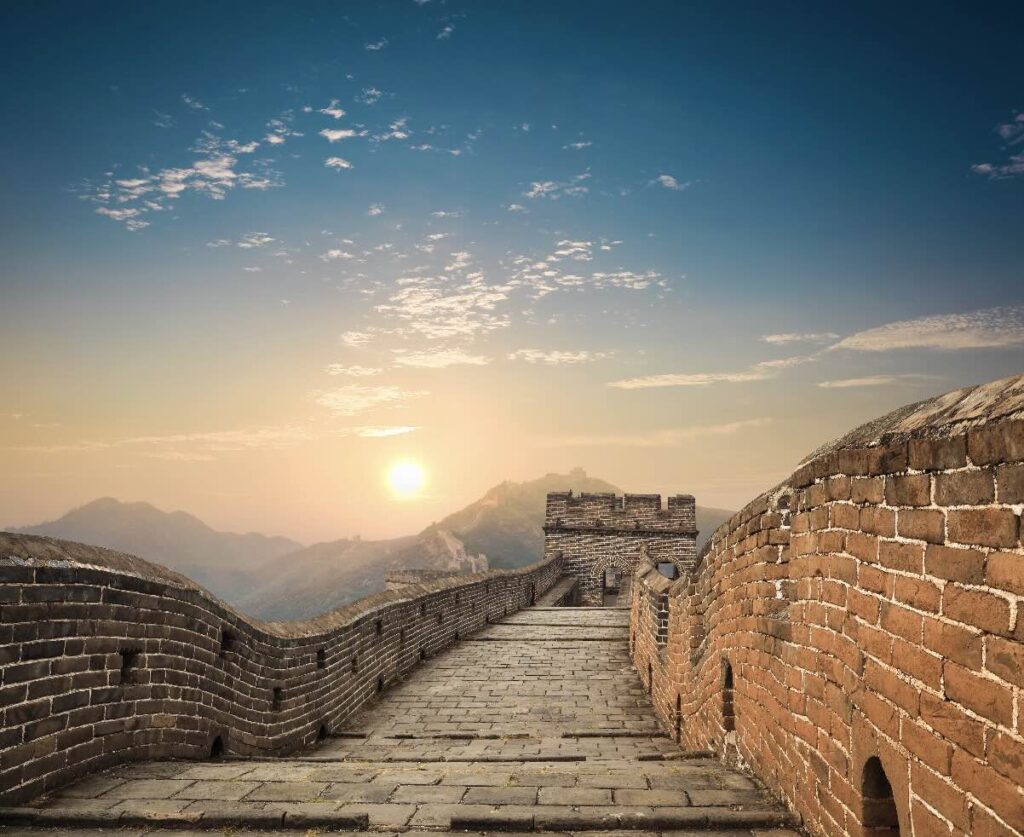You’ve likely heard of the iconic Great Wall of China and know a fair amount about its scale, length, and history – but have you ever stopped to think about how much it weighs? Many assume that such an immense structure must weigh tons, if not billions of tons even, yet the answer is far more surprising.
If you calculate the approximate number of bricks and the weight of each, the Great Wall of China would weigh over 50,000,000 tons. The Great Wall is considered the heaviest continuous structure on the face of the earth. As so many bricks were used to build the wall, if you put all the bricks side by side, it would go around the equator about 36 times. No one knows the exact weight of the Great Wall of China, but we have calculated how much it may weigh and why it is the heaviest structure on the earth.
Table of Contents
- The Great Wall – Heaviest Structure on Earth
- Construction of the Great Wall of China
- 10 Reasons The Great Wall Of China Stands As China’s Pinnacle Symbol
- Frequently Asked Questions
- Related Questions
Read on to take a closer look of the weight of The Great Wall of China and explore possible explanations as to why it is the heaviest structure on earth.
The Great Wall – Heaviest Structure on Earth
The Great Wall of China is considered one of the heaviest things on earth. It is a structure that has lasted through the test of time.

Here Are Some Facts About The Great Wall And Our Calculations To Show How Heavy We Estimate It Is:
- Bricks – The Great Wall has approximately 3,873,000,000 bricks. There are no exact numbers, but this is just an estimate of how many bricks were used for the Great Wall. If all these bricks were placed end to end, then all the bricks would loop about 36 times around the equator.
- Brick sizes – Most of the bricks measure 0.37 meters (1.2 feet) long by 0.15 meters (0.5 feet) wide and 0.09 Meters (0.3 feet) thick.
- Cubic Feet and Weight Calculations – We will then calculate the approximate cubic feet per each brick and figure out the weight of the wall as follows:
- 1.2 feet x 0.5 feet x 0.3 feet = 0.18 cubic feet.
- One cubic foot of bricks weighs about 119 pounds or 54 kilos.
- 3,873,000,000 x 0.18 cubic feet per brick = 697,140.000 cubic feet for the entire Great Wall of China.
- 697,140,000 cubic feet x 119 pounds per cubic foot of bricks = 82,959,660,000 pounds
- 82,959,660,000 pounds = 41,479,830 tons
The Great Wall is the heaviest continuous structure on the earth. An average Egyptian Pyramind weighs about 2.5 to 15 tons, but China’s Great Wall weighs far more than that. The Great Wall, by far, is the heaviest continuous structure on the face of the earth.
My calculations for the weight are conservative as I used the weight for b, which is lighter than stone slabs. Today, our bricks may be a bit lighter than the bricks that many of the ancients used so that they may be closer to the weight of a stone slab.
The Great Wall was built so well and has lasted so long; the materials they used have withstood the test of time.
One cubic foot of stone or granite would weigh approximately 168 pounds per square foot. So if we calculate the weight of the Great Wall based on the weight of granite, the weight would be:
- One Cubic Foot of Granite or Stone slab weighs about 168 pounds per square foot.
- 3,873,000,000 x 0.18 cubic feet per brick = 697,140.000 cubic feet for the enter Great Wall of China.
- 697,140,000 cubic feet x 168 pounds = 117,119,520,000 pounds
- 117,119,520,000 pounds = 58,559,760 tons
We believe that the actual weight of the Great Wall is probably between the weight of the brick and the weight of granite, so the exact weight is perhaps close to 50,019,795 tons.
Construction of the Great Wall of China
The Great Wall of China is known as “Wan Li Chang Cheng” or 10,000 Li Long Wall. The Great Wall of China was one of civilization’s most ambitious building projects ever undertaken.
The construction of the Great Wall was such a vast undertaking that massive armies of soldiers, peasants, and prisoners were used as workers. It is said that at least 400,000 people died during the wall’s construction. Many of these bodies are buried in or near the wall.

The wall construction started in 220 BC when Qin Shi Huang, the first Emperor of China, ordered that many walls along the northern border be joined into a single system to help protect China against the invaders of the north.
The great wall is made mainly of the earth in stone. It stretches from the China seaport of Shanhaiguan to over 3000 miles west of the Gansu Province.
In some locations, the wall overlapped to give extra protection.
Even though the wall started in 220 BC for many years, the wall was in disrepair. The Ming Dynasty (1368 to 1644) tirelessly maintained and reconstructed the Great Wall of China. They saw it as a way to help prevent an invasion from the north.
The wall was impregnable for a long time and helped protect the Ming Dynasty from the invaders to their north. The Ming Dynasty also added parts and expanded other parts of the Great Wall.
The Great Wall of China was a vast construction project that lasted centuries. Not just one person or era constructed the wall, but the wall was built over hundreds of years.
10 Reasons The Great Wall Of China Stands As China’s Pinnacle Symbol
Winding its way across deserts, mountains, and grasslands, the Great Wall of China is an architectural marvel and an embodiment of China’s rich tapestry of history, culture, and endurance. Its grandeur and expanse have made it a global icon, but it holds even deeper significance to China and its people.

Here are ten reasons why the Great Wall remains an unrivaled symbol of China:
- Historical Legacy: Spanning several dynasties and over two millennia, the Great Wall stands as a tangible chronicle of China’s long and intricate past, bearing witness to epochs of construction, conflict, and consolidation.
- Engineering Marvel: Showcasing ancient China’s architectural prowess, the Wall, with its fortresses, watchtowers, and battlements, is a testament to the nation’s advanced engineering and construction techniques of the time.
- Unyielding Defense: Built primarily as a defense mechanism against invasions, the Wall symbolizes China’s protective spirit and its historical determination to safeguard its people and territories.
- Cultural Unity: Beyond its military function, the Great Wall also played a crucial role in integrating different provinces and cultures, fostering a unified Chinese identity.
- Economic Significance: The Wall protected and facilitated trade routes, especially the fabled Silk Road, aiding in the exchange of goods, culture, and knowledge between the East and West.
- Symbol of Endurance: Withstanding the ravages of time, natural elements, and human conflicts, the Wall stands as a testament to resilience—a quality deeply ingrained in the Chinese psyche.
- Geographical Splendor: Traversing a diverse array of landscapes, from the Gobi Desert’s sands to rugged mountain terrains, the Wall underscores China’s vast and varied geographical expanse.
- Global Recognition: As a UNESCO World Heritage site and one of the New Seven Wonders of the World, the Wall attracts millions of tourists annually, spotlighting China’s historical and cultural richness on the world stage.
- Artistic Inspiration: Over centuries, the Great Wall has inspired countless poems, paintings, and literary works, echoing its emotional and symbolic resonance in the collective Chinese consciousness.
- Emblem of Unity and Strength: Beyond bricks and mortar, the Great Wall represents the collective spirit, tenacity, and unity of the Chinese people—a binding thread that weaves past glories with future aspirations.
The Great Wall of China transcends its physical presence. For China and its people, it stands as a sentinel of history, a beacon of culture, and a promise of continuity, making it an everlasting symbol of the nation’s heart and soul.
Listen To Our Podcast About The Weight of History: Unveiling the Surprising Mass of The Great Wall of China Below or By clicking here.

At A Bus On A Dusty Road, we talk about everything about travel, life, and ex-pat living. We are all about “Living Life As A Global Citizen.” We explore social, cultural, and economic issues and travel.
We would love to have you be part of our community. Sign up for our newsletter to keep up-to-date by clicking here. If you have any questions, you can contact me, Anita, by clicking here.
Listen to our Podcast called Dusty Roads. You can find it on all major podcast platforms. Try out listening to one of our podcasts by clicking here.
Subscribe to our A Bus On A Dusty Road YouTube Channel filled with great videos and information by clicking here.
Frequently Asked Questions
What is the Great Wall of China?
The Great Wall of China is a massive fortification built across China’s historical northern borders to protect the country from invasions.
How long is the Great Wall?
The Great Wall stretches approximately 21,196 kilometers (13,171 miles) across China, including its various branches.
When was the Great Wall built?
Construction of the Great Wall started as early as the 7th century BC and continued over several centuries, with major expansions occurring during the Ming Dynasty (1368-1644 AD).
How many people worked on building the Great Wall?
It is estimated that millions of workers, including soldiers, peasants, and prisoners, contributed to the construction of the Great Wall over its long history.
Can you see the Great Wall from space?
Contrary to popular belief, the Great Wall is not visible from space with the naked eye. It is challenging to spot any specific man-made structure from such a distance.
Is the Great Wall a single continuous structure?
The Great Wall is not a single continuous wall but rather a series of interconnected walls, towers, and fortifications built at different times and by different dynasties.
Can you visit the Great Wall of China?
Yes, many sections of the Great Wall are open to the public and can be visited by tourists. Popular sections include Badaling, Mutianyu, and Jinshanling.
How did the Great Wall contribute to China’s defense?
The Great Wall served as a defense against invasions, providing a barrier against enemy forces and acting as a communication system for military operations.
Related Questions
Where Does The Great Wall Of China End?
The Great Wall ends at what is known as the Jianyu Pass; this Jianyu Pass is the westernmost part of the Great Wall and also was known as the “First and Greatest Pass Under Heaven.” Some called it is the gates at the Jianyu Pass, the Gate of Travelers, and the Gate of Sighs.
You can learn more by reading Where Does The Great Wall Of China End? by clicking here.
How Long Did It Take to Build the Whole Great Wall of China?
The Great Wall of China took over 2,000 years to build. The building span over many Chinese Dynasties or for about 22 centuries. The construction of the wall ended in the Ming Dynasty in 1644. The Great Wall is one of the most significant human-made construction projects globally; the Great Wall is over 21,196 kilometers or 13,171 miles. There are over 25,000 watchtowers scattered throughout the Great Wall structure.
To know more about How Long Did It Take to Build the Whole Great Wall of China? by clicking here.

